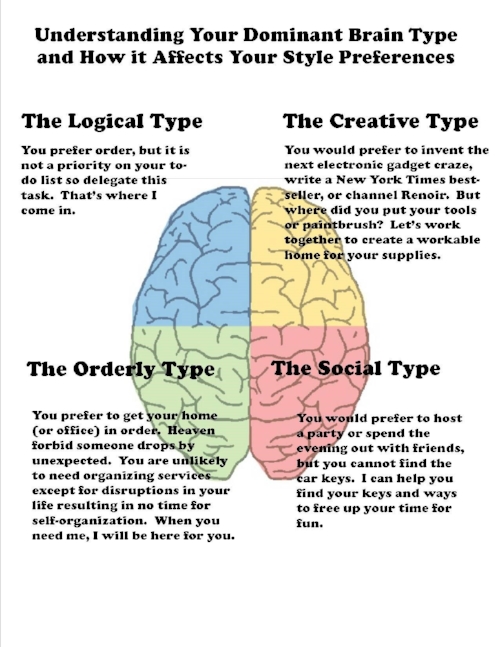“Most people want to be successful. When their efforts are a hit, they may not know how to replicate that on a consistent basis. When their efforts result in a miss, they may have difficulty figuring out how to prevent similar misses in the future.
The practical application of brain-function strategies may contribute to more hits and fewer misses. My goal is to provide brain-function resources to help you choose a happier, healthier, and more energy-efficient life.
—Arlene R. Taylor, PhD”
Temptation vs. restraint one is easy, one is hard
A luscious chocolate brownie, gooey steaming pizza, or icy cold craft brewed beer on your countertop beckons for your attention. If you have no food restrictions, you go for it, no hesitation. The aroma is almost too much to bear. You don't need any prompting to satisfy the craving. You just do it. Then you savor the creamy richness as the flavor electrifies your taste buds. Life is good.
Now imagine the same temptation, but sadly you're on a diet, have food intolerances, or any other health condition that precludes grabbing and enjoying. Walking away is very hard. You delve deep into your core for the willpower to leave it there. Why is it so difficult to abstain? Because you are working against what you want, what your stomach wants, or even the messages that parts of your brain are sending.
Whether it comes to resisting food or tackling tasks around your home, when we work against the messages we are receiving, we can find ourselves on an uphill slog. On the flip side, when you work in harmony with your natural tendencies, chances are you don't give the task a second thought. It just happens with little cognition or effort.
Will you reach your destination facing the wrong direction?
Think about this. You arrived home from work. As you get out of the car, you realize you cannot recall most of the ride. You may have been rocking out to songs without consciously thinking about the lyrics. A little disconcerting to say the least yet your brain had you covered as you drove on auto-pilot. The driving was routine and therefore, unless something drastic happened to startle you out of the reverie, the commute took little thought.
Will you reach your destination if you are facing the wrong direction?
If your compass is off, getting to your intended destination won't be easy. You will head in the wrong direction or the route will be circuitous. Eventually you might get there, but the price is wasted time, gas and tense neck and shoulder muscles. Once you reorient yourself, you begin advancing toward your goals. The end results seem so very far away, but with every step or mile you drive, heading in the right direction will get there much sooner.
Chaos is an unwelcome thief
Living in chaos and disarray is not fun. It robs your energy, it inflames your relationships, it slows you down, it stresses you out, and quite possibly destroy your career. You may have decided that the situation is no longer working for you, and a shift in direction is necessary. How do you motivate yourself to make the change? How do you stay motivated? How do you take the first step?
Brain typing based off the Hermann Brain Dominance Instrument
Once we understand where you are coming from, we can get you where you want to go. You would be surprised how often our innate preferences creep into our vocabulary. Do you ever find yourself saying things like "I see what you mean" (visual sensory preference), "I hear you" (auditory sensory preference), "I feel you" (kinesthetic sensory preference). These messages give you some clues as to how you process information.
Your Dominant Brain Type is your compass: Right vs Left
How you react in situations might signify from where you draw your prevailing strengths indicating your dominant brain type. Think about this scenario, you have finally made the commitment to address the massive paper pile on your desk on Saturday morning. Saturday arrives and a friend phones giddy with excitement that Nordstroms is having a major sale. The dress you have been eyeing for your anniversary party is now 50% off. She says "I will be by in 30 minutes to pick you up." You are itching with anticipation, ladies day at the mall. Oh, maybe she will want to swing by the Cheesecake Factory for lunch and a catch up chat afterward. So much has been happening in your life that you want to share. That pile on your desk is long forgotten, but heck you are going to have an awesome time. If you are thinking, yep that's me, you are drawing upon the strengths of your Social brain type.
Now let's get back to that desk, for the Creative/Inventive's mind is churning out visions of multi-colored bins with hand-painted lettering labeling the contents. The bins will be housed in the mid-century shelving unit you bought at the thrift shop. Will you ever get to painting the shelves and creating the bins? Who knows? But in your mind, they look super cool just like the ones you saw on Pinterest.
The creatives and socialites reside in the right hemisphere of the brain, the former in the front, the social butterfly is flitting in the back.
Now let's switch to the opposite side. Chances are that if you are drawing your dominance from the left hemisphere of the brain, that desk would not have accumulated the mess unless the situation was beyond your control for any reason. And, if that is the case, it will likely drive you to distraction. A birth, death, divorce, new job, home remodeling project, difficult work situation, all of these tend to cause someone with an Orderly brain type (left rear quadrant) or the Logical/Executive brain type (left front quadrant) to feel agitated, overwhelmed, and crying out for order.
If you are an orderly brain type you will likely ensure that the piles are dealt with before your friend arrives or decline the invitation. Your file folders are clearly labeled in your credenza, so get out your shredder to ditch those you don't need and slip the rest into their respective folders. If you are the executive type, you might delegate the task to someone else or take some time to thoughtfully analyze the situation and viable options before reacting either way.
If it is imperative that the piles get dealt with immediately, but you are on the right side, here's a thought. As a social type, you could explain the circumstances to your friend and ask if she is either willing to help you blow through the piles so you are able to shop with her a little later than originally scheduled or offer her a latte and a bagel to munch while she sits in the room dishing up the juicy topics you were going to cover at the Cheesecake Factory as you work. Just having her company makes the task much more palatable (be sure not to let her distract you from the task). She might even have a suggestion or two how to sort through the papers faster or whether you should keep or dispose of questionable documents and the best placement of the keepers as you throw your hands in confusion.
You've identified as a creative? Grab any bins for now, doodle some quick labels put them on the unpainted shelves, then shop for more decorative options and a can of Metro paint (much less expensive recycled option, click here for swatches) on your outing. Once you get back from the mall, you will need "me" time, a perfect opportunity to let those artistic juices flow all over the bins and shelves. This is your form of chilling.
A few questions will get your sort sorted
So what is your dominant brain type and how does it affect your behaviors? There are two assessments that I offer my clients to guide us through our work together for a more directed, fruitful and sustainable approach. Care to know your dominant strengths and sensory preferences if you have not already figured them out? Take the assessments here. Although we hopefully use all of our brain's quadrants, one style typically stands out, the same with sensory preferences. We will cover sensory preferences and options for being more in tune with them in a future blog. Granted there has been some controversy about the simplification of these brain type theories, and I realize that I am relying upon sweeping generalizations. However, from what I have noticed these guidelines provide a starting point to tailor strategies for moving forward in a more productive way. Consider them a roadmap. No one mandates that you have to take a certain route, but choosing the one that makes the most sense such as picking up dry cleaning or a child at day care along the way can alter which route you take to your ultimate destination. The one that suits your criteria will lead to the most fruitful outcomes.
Want to create a more harmonious relationship between your home, daily tasks, and brain? Are you looking for more ideas how to incorporate strategies that draw upon your strengths and simplify how you operate? Visit ThePracticalSort.com's Brain-Based Organizing page here.
We all have our vulnerabilities and challenges, and sometimes we need a hand to make sense of it all. Feel free to reach out to me if you are struggling with wrapping your head around your to-dos and how best to tackle them at ThePracticalSort. Also, click on the bold font to check out Dr. Arlene Taylor's website which has numerous brain function resources. I love her Brain Exercises. She also features recipes that are ideal for optimal health. I am indebted to her for granting me permission to use her Sensory Preference Assessments to help my clients reach their organizing potential.
Left Hemisphere
Thoughts about left hemisphere organizing
Right Hemisphere
Thoughts about right hemisphere organizing








